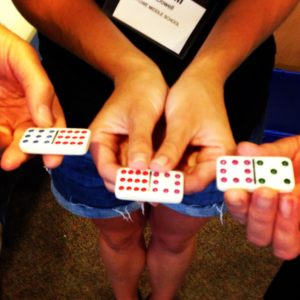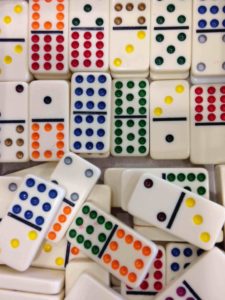Apr 08, 2018 Domino Fraction Line Up: An Accidental Success in the Classroom
I find that some of my best activities and strategies are created by accident, when a lesson plan doesn’t go quite as I planned, or when an unexpected situation arises and I have to adapt quickly. One of my favorite formative assessment, social-emotional learning, and math review activities came about this way.
In my direct service work in K-12 classrooms, I use line-up activities as fun filler or quick team-builder activities during transition times. When there are 5 minutes left in class, I simply ask students to “Line up at the door in order of shoe size without talking,” or “See how fast you can line up by your birthdays,” etc.
 A few years ago When Yolanda D’Allesio asked me to help her 7th-grade math students reflect on the frustrations they were experiencing around problem-solving, I used domino pairs as an entry-task, partner-dialogue activity. Students were about to share with the whole group when Yolanda had to leave the room unexpectedly. I needed something to engage them until she returned, so the paraprofessional Ginny Cunningham, and I improvised. She mentioned that students had just finished a unit on fractions. This inspired me to ask the students to line up by their “domino fraction.” I was amazed at how well it worked. As with other active review methods and problem-solving challenges, the non-hand raisers took the lead, helping classmates organize and simplify fractions. The Domino line up became a useful formative assessment tool, revealing who truly understood and could articulate their understanding about reducing and converting fractions. At the same time, students were problem-solving, collaborating, using their creativity, and practicing communication skills.
A few years ago When Yolanda D’Allesio asked me to help her 7th-grade math students reflect on the frustrations they were experiencing around problem-solving, I used domino pairs as an entry-task, partner-dialogue activity. Students were about to share with the whole group when Yolanda had to leave the room unexpectedly. I needed something to engage them until she returned, so the paraprofessional Ginny Cunningham, and I improvised. She mentioned that students had just finished a unit on fractions. This inspired me to ask the students to line up by their “domino fraction.” I was amazed at how well it worked. As with other active review methods and problem-solving challenges, the non-hand raisers took the lead, helping classmates organize and simplify fractions. The Domino line up became a useful formative assessment tool, revealing who truly understood and could articulate their understanding about reducing and converting fractions. At the same time, students were problem-solving, collaborating, using their creativity, and practicing communication skills.
Facilitation Suggestions
 Materials: Dominoes— double 12s make this more interesting and challenging. Choose your sets by the ages and abilities of the groups with which you are working.
Materials: Dominoes— double 12s make this more interesting and challenging. Choose your sets by the ages and abilities of the groups with which you are working.
• Hand each participant a domino
• Ask them to line up by their domino fraction’s value, from smallest to largest.
• I don’t tell students where to begin and end—the less said by me, the more creativity they
will use.
• Take this one step further, and have students convert their domino fractions into decimals. This can lead to discussion around percentages.
Domino Equations Variation
I sometimes challenge elementary students to form one whole group matching their dominoes or form simple math equations (using the appropriate dominoes). This is not only an active way to partner and practice math, but it also introduces a game to the classroom that might be new to many students. Good old-fashioned dominoes could be novel to a group of young students who mostly play computer games.
Reference: Inspired Educator, Inspired Learner: Experiential, Brain-Based Activities and Strategies to Engage, Motivate, Build Community, and Create Lasting Lessons by Jennifer Stanchfield 2014 Wood N Barnes Publishing.



No Comments